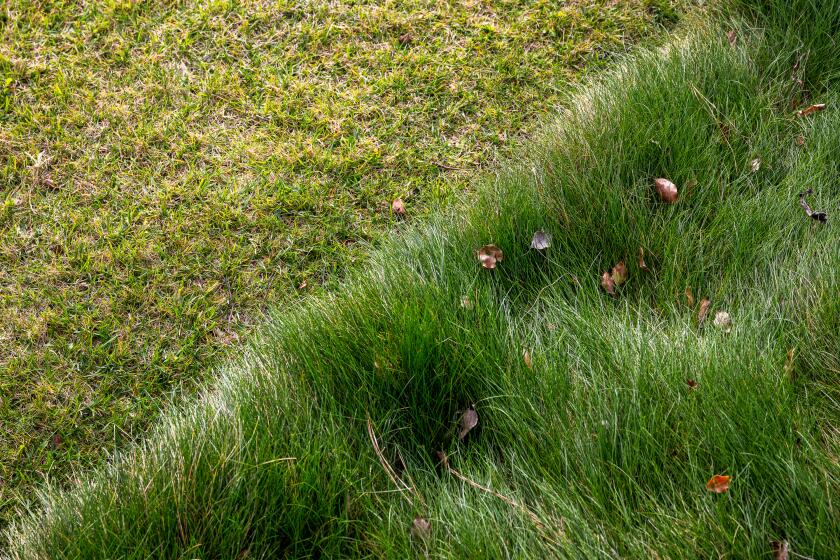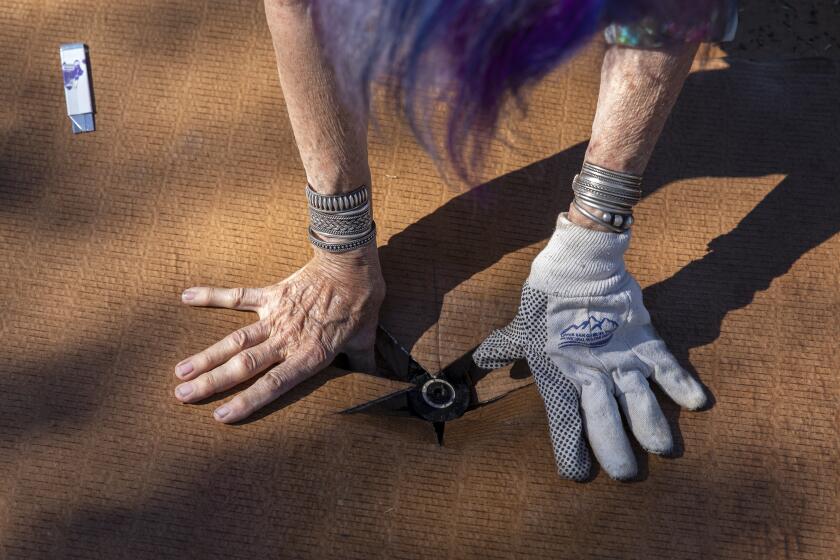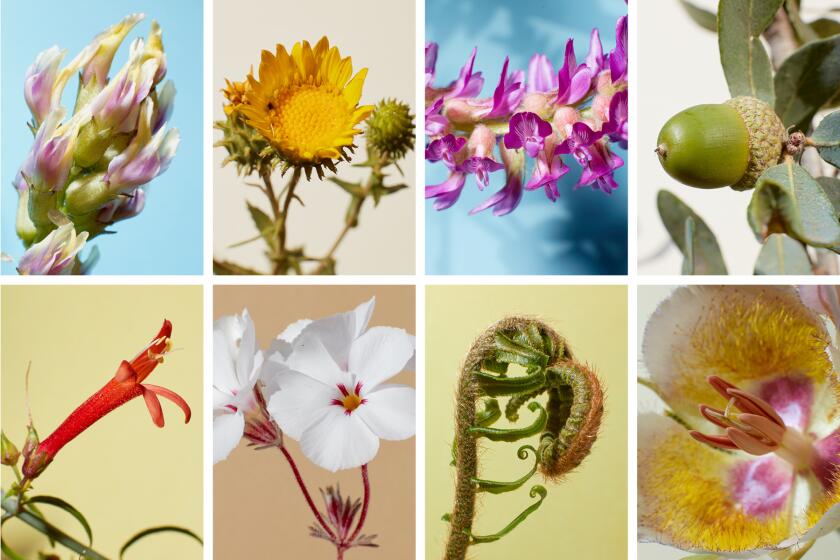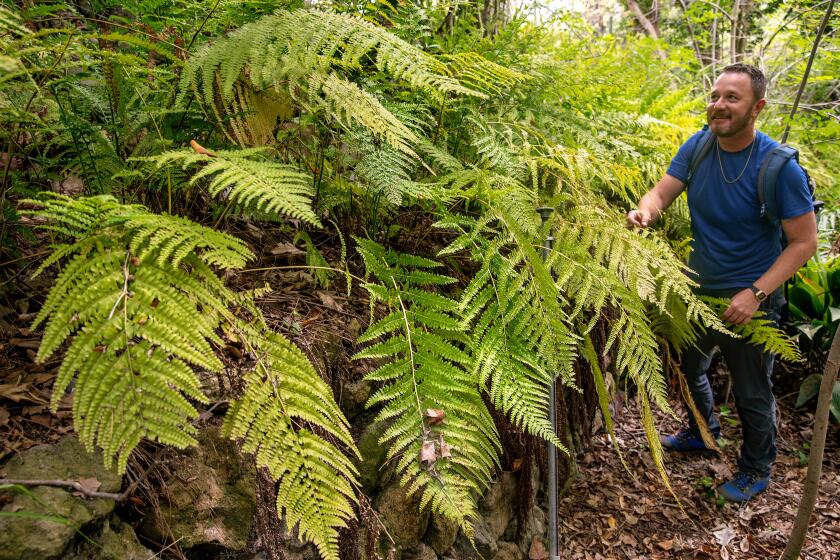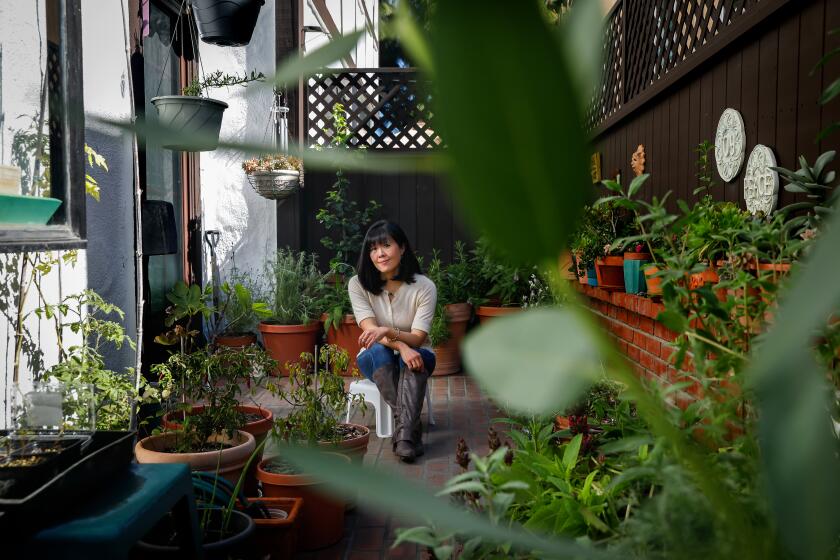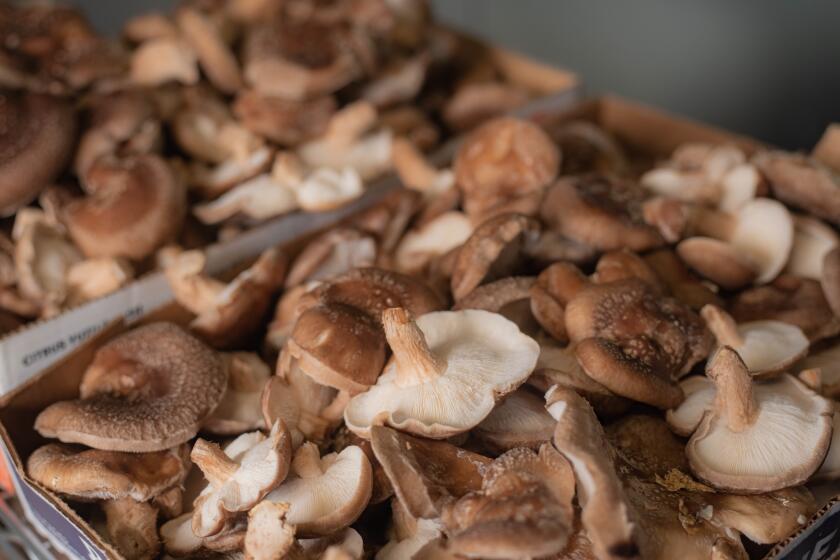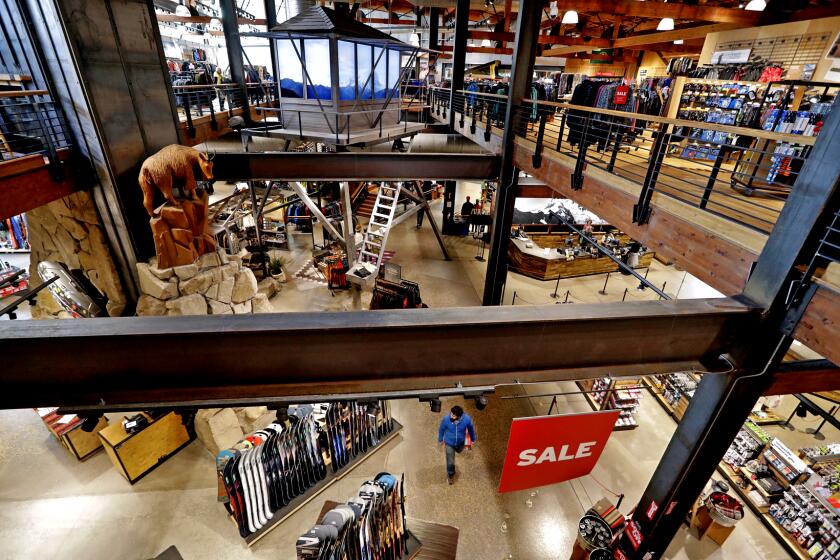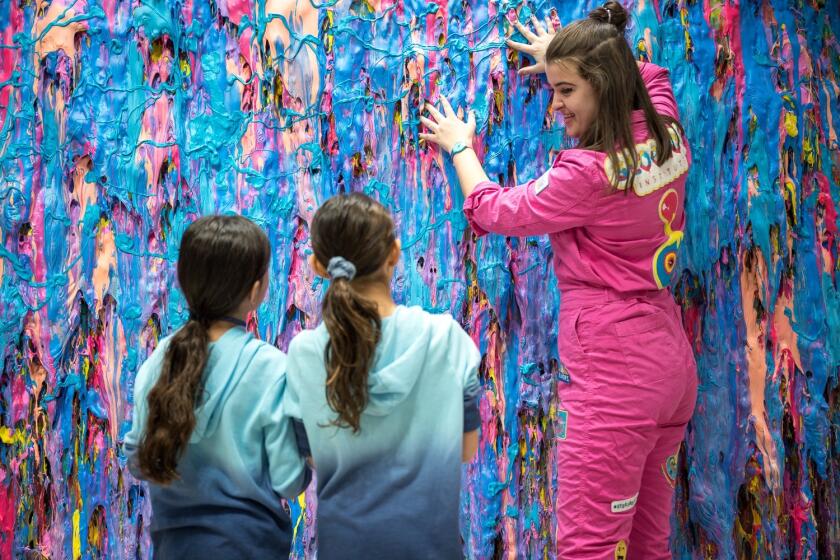The blistering hatred for fake grass
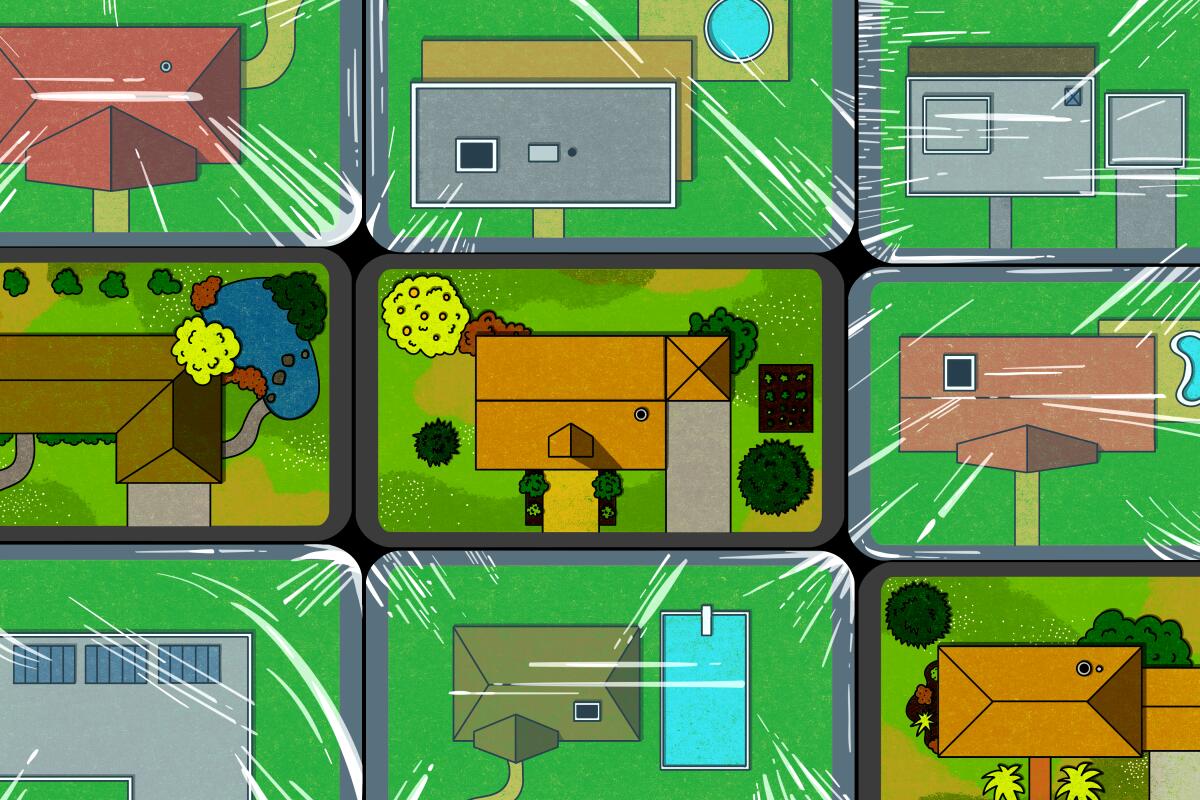
Welcome to February, and, sad to say, what will likely be the last issue of the L.A. Times Plants newsletter — more about that in a moment. Just know that we still have a good list of plant-related activities and classes for February below.
But if this is my swan song for L.A. Times Plants, I’d like to discuss an important topic that causes much teeth-gnashing and despair among advocates for the natural world — the dreaded plastic carpet “lawn” known as artificial turf.
The subject came up repeatedly last month while I was researching native grass alternatives for traditional turf. I soon learned that even the mention of fake grass was enough to set off blistering rants.
“I do not have enough negative things to say about it,” said Briana Lyon of the online nursery California Wild Gardens, but she certainly made a good effort.
“It’s extremely toxic to the environment, it sheds micro plastics nonstop and it’s a single-use plastic that usually ends up in a landfill because it doesn’t decompose,” she said. “It breeds bacteria from animal waste, it’s as hot as concrete ... and it destroys the soil underneath. ... It takes months to repair the soil when you remove it. I would rather see people plant traditional water-guzzling turf rather than artificial turf.”
Tearing out your lawn but still want a swath of green? Try planting water-saving (and labor-reducing!) California native grasses instead.
Toxic to the environment? Gov. Gavin Newsom approved a bill in October that permits cities and counties to ban artificial turf because it contains toxins like lead and PFAS that can leach into the soil. Newsom refused to sign a bill that would have banned the turf completely, not because he didn’t agree with the sentiment but because the bill didn’t include a regulatory agency that would enforce the ban.
As hot as concrete? Maybe hotter.
Back in 1981 William B. Davis, a UC Davis environmental horticulturalist, did a study comparing the temperature of bluegrass cut to varying heights and artificial turf on a 78-degree day in October. Interestingly, the bluegrass turf got cooler as it got longer — about 67 degrees at 6 inches of height to 83 degrees at a half inch of height. But the artificial turf clocked in at 125 degrees, 46 degrees above the air temperature.
Janet Hartlin, horticulturist for the Los Angeles County UC Cooperative Extension office did her own study in 2021, writing that “synthetic turf, dark mulch and asphalt surfaces are superheating our inland cities,” and of the three, synthetic turf was the hottest of all. Her research showed that “synthetic turf reached temperatures over 165 degrees in Palm Springs and 159 degrees in Redlands on days when the air temperatures were, respectively, 113 and 108 degrees in July of 2021.”
Just take a minute to consider how that would affect the temperatures of a neighborhood if all the “lawns” were made out of plastic, especially if that neighborhood doesn’t have any shade trees. It’s kind of like sitting next to a roaring fire during summer’s blistering heat. Why would you want to introduce those kinds of temperatures to your yard?
And yet, people keep ripping out their lawns and installing artificial turf to save water and effort. The theory, I guess, is that upkeep is easy, water bills are zero, and your lawn looks perfect every day.
Christie and Ray Mahr say they were seduced by that promise when they tore out their time-consuming traditional turf lawn in Ventura and installed synthetic turf. They were sick of all the mowing and edging and constant watering to keep it green, and having to reseed to cover spots where their two dogs liked to romp. But what they discovered about an artificial lawn wasn’t pretty, Christie said.
“First of all it just looked fake,” Christie said. “I mean, they’ve come a long ways but it still looked fake and you couldn’t walk on it in the summer. It was way too hot to go barefoot. And the dogs wouldn’t touch it, except to pee. We had to put drainage holes in for when they peed but it doesn’t absorb anything and it doesn’t really wash out, so it got to the point that it would kind of smell. You’d have to hose it down or use a blower to blow off the leaves and other debris.”
Here are the best retail native plant nurseries in Southern California to help you create a habitat for birds and pollinators in your yard or even on a patio.
After about a year, they finally ripped up the synthetic lawn and replaced it with Kurapia, a sterile hybrid of the native groundcover lippia (Phyla nodiflora), which they love for its ease of care and low water needs. And where their dogs once again love to romp.
I could add a parade of comments from people who despise artificial turf, but I think horticulturist and author Carol Bornstein, the guru of native plant landscaping, says it best:
“I keep seeing more and more installations of fake grass in my immediate neighborhood, as though it’s a knee-jerk response: rip up your lawn and put down plastic. And each new installation raises my blood level,” she said. “A lot of people don’t understand natural processes and how important they are to our well-being; not just other creatures, but our well-being. Landscapes are not static things; they are dynamic. They are supposed to grow.”
And here’s where I get emotional, because these days, anyone who has a yard in Southern California is very lucky indeed, yet so many of us treat our tiny natural space as an afterthought. We cover it with grass, a few boring shrubs and grimace every time we have to mow, or pay someone else to mow. There’s no question that gardening requires some effort, but in my experience, it is well rewarded. There is satisfaction in helping things grow and a small joy you can share with others. (I write this watching children walking to school, delightedly picking my tall dandelions and blowing seed puffs into other parts of my yard. Oh, well.)
It feels like a bad case of Something-for-Nothing syndrome: I can have a perfect yard without any effort or expense (past the installation) by just laying down this piece of plastic and walking away.
But as Bornstein says, yards are places where things grow and change, even on turf lawns when clover and dandelions bloom and leaves fall and the worms wriggle out of the ground after a heavy rain. This is all part of our world, and if we keep smothering the soil and all the goodness it can grow, it’s going to go away — and maybe poison us in the process as it departs.
As the drought continues, Californians are tearing out their lawns. Here’s a DIY guide to killing grass to prep for a drought-tolerant landscape.
Which brings me to my other point, about the L.A. Times, a place I’ve been so blessed to work at for the last five years, and will soon be departing because of the devastating layoffs that were announced last week.
The bottom line is that businesses like the L.A. Times can’t survive unless people subscribe. The deal offered now is $1 for six months, and then $16 a month after that for a digital subscription. Just $16 a month to access prize-winning photography, story-telling and news that comes from an identifiable source, someone who must be held accountable for their work.
I firmly agree with the Washington Post’s slogan: “Democracy Dies in Darkness.” And, I truly believe community dies as well. California is facing lots of changes and difficult decisions, from how to provide homes for the unhoused to how people lucky enough to have homes can sustainably landscape their yards. The Times helps us consider those issues and make informed decisions, but no publication can continue in a something-for-nothing environment. It requires financial support to survive.
Sending you all my very best wishes and hopes for a greener future, full of shade trees, chirping birds, abundant gardens and uplifting fragrance every time you step outside. It’s been an honor to work for the L.A. Times, and write for you all. I hope to share ideas with you again in the future. You can reach me at jeanettemarantoslovesplants@gmail.com. And if you have plant-related story ideas for The Times going forward, you can email Features Editor Brittany Levine Beckman at brittany.beckman@latimes.com.
To keep hearing from the L.A. Times in other ways, sign up for The Wild, our weekly newsletter about hiking and outdoors adventure, or get our most important journalism in your inbox every morning by signing up for Essential California.
You’re reading the L.A. Times Plants newsletter
Jeanette Marantos gives you a roundup of upcoming plant-related activities and events in Southern California, along with our latest plant stories.
You may occasionally receive promotional content from the Los Angeles Times.
Upcoming events
Consider subscribing to the Los Angeles Times
Your support helps us deliver the news that matters most. Become a subscriber.
First, a reminder that many organizations offer multiple opportunities to get outside and make a difference in our natural world with tree planting and habitat restoration, including TreePeople, the South Bay Parkland Conservancy, Friends of Ballona Wetlands, Santa Monica Mountains Fund and the Palos Verdes Peninsula Land Conservancy. If you want to get involved, any of these organizations has plenty to keep you busy.
Also note that Tomatomania begins its annual pop-up sales of about a kajillion different varieties of tomato and pepper plants (well, that’s a slight exaggeration... more like 100+ different varieties) on March 1, so start thinking about getting your garden area prepped because spring is coming fast!
Today, Feb. 5, 7 & 10
Succulent Heart Topiary Workshops, a two-hour class in creating heart-shaped topiary with succulents at Growing Works Wholesale Nursery in Camarillo (open for retail sales the second and fourth Saturday of every month from 10 a.m. to 2 p.m.). Classes start at 5:30 p.m. tonight and on Feb. 7, 10 a.m. on Feb. 5, and 10 a.m. and 12:30 p.m. on Feb. 10. All materials provided; tickets are $55. Proceeds support the nonprofit Turning Point Foundation’s programs for adults with mental illness. eventbrite.com
Feb. 8
Floral Design Workshop with Ghanaian multimedia artist Nelson ZêPequéno, 5 to 7 p.m. in downtown L.A., a hands-on workshop about how to choose flowers and foliage for color, shape and size before arranging. The class includes fresh flowers to work with and binding materials to hold your bouquet. Advance registration required; tickets are $100. usalproject.com
At 34, Matt Smith is a widower and amateur botanist whose grief and passion are fueling a quest some might call quixotic — to photograph every plant native to Los Angeles County.
Feb. 9
California Native Plant Maintenance Basics, a walk and talk class with Theodore Payne Foundation Horticultural Director Tim Becker, 9 to 11 a.m. at the foundation’s demonstration garden in Sun Valley. Tickets are $35 ($25 for members). eventbrite.com
Feb. 10
WISDOM: Making Conservation More Inclusive, is a free conference and mixer hosted by the Mojave Desert Land Trust devoted to the need for more diversity and inclusion in the conservation sciences of the California desert, 3 to 7 p.m. at the UC Riverside Campus Alumni and Visitors Center Dining Room in Riverside. Advance registration is required for the event, which includes speakers, breakout sessions and networking opportunities about how to address inequalities in desert conservation field work. mdlt.org
Plant Identification Hike with naturalist and outdoor educator Jason “Journeyman” Wise, 11 a.m. to 1 p.m. at Elysian Park Arboretum. Learn how to identify native and nonnative plants and animals in our local wild areas by using your five senses. Advance registration required, tickets are $35. usalproject.com
Veggie Plant Sale by master gardener Yvonne Savio, 10 to 11 a.m. at the Altadena Community Garden in Altadena. Savio, creator of GardeningInLA.net, is selling 4-inch containers of cool-season vegetable seedlings she started in her garden, including artichoke, broccoli raab, broccolini, cauliflower, chard, kale, lettuce, pak choi and sunflowers. Admission is free; each container is $3 and holds several plants. Cash only. altadenacommunitygarden.com
Sunset Queer Ecology Walk with naturalist and outdoor educator Jason “Journeyman” Wise, 4 p.m. at Griffith Park. Learn how the natural world reflects our own diversity on an easy two-mile hike. Advance registration is required; tickets are $10. eventbrite.com
For Jason Wise, knowing more about the natural world could’ve fortified him growing up in a conservative religious community. Now he’s sharing his queer ecology knowledge on hikes for Pride Month.
Feb. 11
Chile: More Than Copiapoas, a free talk about copiapoa cactus, their care and the types found in Chile by longtime cactus and succulent collector Gary Duke, 1 p.m. at the South Coast Cactus & Succulent society monthly meeting at the South Coast Botanic Garden in Rolling Hills Estates. southcoastcss.org
Feb. 13
Native California Ferns, a free talk by California Botanic Garden horticulturist Ashlee Armstrong, 7:30 p.m. at the monthly meeting of the Los Angeles International Fern Society in the Bamboo Room at the Los Angeles County Arboretum in Arcadia. laifs.org
Feb. 17
Citrus Care and Pruning Workshop, by the UC Cooperative Extension Master Gardeners Orchard Team, 9 to 11 a.m. in Ishihara Park Learning Garden in Santa Monica. The workshop is free but advance registration is requested and participants should bring gloves, pruning shears and their own dishes for food and drink. The workshop includes activities for children. santamonica.gov
Invasive Plant Foraging Walk with naturalist and outdoor educator Jason “Journeyman” Wise, 2 to 4:30 p.m. at Elysian Park Arboretum. Learn how to identify and devour nonnative invasive edible plants growing in the hills around Los Angeles. The event includes an easy two-mile hike, gathering edible nonnative plants and making them into a salad to eat. Advance registration required, tickets are $20. eventbrite.com
The Meaning of Flowers and How to Preserve Them, a free talk by TV and radio horticulturist Nick Federoff at 11 a.m. at the Pomona Home & Garden Show at the Pomona Fairgrounds. Admission to the show is free. homeshowconsultants.com
Barbara Chung fell in love with native plants, but she didn’t have a yard. So she created a habitat garden in pots on her tiny townhouse patio in Santa Monica.
Feb. 22, 29 & March 7
Gardening With Native Plants, a three-session Conejo Valley Adult School class from 5:45 to 7:15 p.m., taught by Bob Sussman, owner of Matilija Nursery in Moorpark, covering simple landscape design and maintenance of native plants in sunny and shady areas. Registration is $55. cvae.asapconnected.com
Feb. 22
Sowing the Seeds of Change With California Native Plants and Sustainable Gardening Practices, a talk by horticulturist Andrew Chaves, director of operations at Rancho Los Alamitos, 6 p.m. at the Rancho in Long Beach. Tickets are $10 (free for members) and available online. rancholosalamitos.com
Feb. 23
Understanding Oaks: A Tree Walk and Talk With Arborist Alison Lancaster, 9 to 11 a.m. at the Theodore Payne Foundation grounds in Sun Valley. The event includes information about the oak tree life cycle, diseases and proper pruning and watering. Advance registration required; tickets are $34 ($25 for members). eventbrite.com
Feb. 24
Soil Safari, a 3.5-hour hands-on soil science class taught by ecological systems designer, landscaper and author Nance Klehm, 1 to 4:30 p.m. at Arlington Garden in Pasadena, where participants will assess the soils underfoot and learn about soil texture, aggregation, composition and percolation. Tickets should be purchased in advance, $60 to $90, depending on ability to pay. arlingtongardenpasadena.org
Kids’ Day at Growing Works with biologist Erik Oberg. In this 90-minute class, children will learn how to plant and care for the California native plant of their choice and leave with the plant they choose. Children must be accompanied by an adult, 10 a.m. at Growing Works Wholesale Nursery in Camarillo. Tickets are $10 and include all instructions, plant and materials. eventbrite.com
Carts, cash, recycled yogurt containers and making friends with vendors are just some of the ways pro shoppers conquer Los Angeles farmers markets.
Feb. 25
Farmers Market Tour with chef-farm liaison Sam Rogers, 6:30 to 10 a.m. at the Hollywood Farmers’ Market. The tour includes instruction about California’s many micro climates and growing conditions, practical tips for selecting produce and why certain varieties are better for cooking than others. Advance registration required. The $80 ticket includes a box of fruits and vegetables. usalproject.com
Reading the Weeds, a botanical workshop by ecological systems designer, landscaper and author Nance Klehm, 1 to 4:30 p.m. at Arlington Garden in Pasadena, where participants will learn what the weeds in their yard say about their soil structure and health, hydrology, mineral concentrations and imbalances, and possible contamination, as well as which weeds are good for eating, medicinal purposes and compost. Tickets should be purchased in advance, $60 to $90, depending on ability to pay. arlingtongardenpasadena.org
Finding our Way Home With Fungi, a walk and talk with mycologist Aaron Tupac, 10 a.m. to noon at the Altadena Trailhead in Altadena to learn more about fungi and their relationships with other plants and animals. (This is not a foraging class.) Advanced registration is required, tickets are $35 ($25 for members of the Theodore Payne Foundation, free to children under 12). eventbrite.com
Growing mushrooms at home is more complicated than buying soil and seeds, but very doable with the help of premade kits. Here are expert tips on mushroom care.
Feb. 29
Propagating California Native Plants from Cuttings with Genevieve Arnold, seed program manager for the Theodore Payne Foundation, 9 a.m. to noon at the foundation’s nursery in Sun Valley. Participants will leave with a flat of 50 starts for their own garden. Advance registration required, tickets are $85 ($75 for members). eventbrite.com
What we’re reading
The trademarked name Kurapia may not be the best advertisement for this sterile hybrid of the California native lippia plant, but proponents are singing its praises as a great choice for an evergreen, easy-care lawn that requires almost no water. Of course, there are also other native grasses for people who want lush, easy-to-care-for lawns. Check out our list of four choices.
Ryan Bradley’s beautiful testimony to the greatest trees of Los Angeles took my breath away, as did the photos by Devin Oktar Yalkin. Be sure to read this extraordinary deep dive into our city’s fabled trees, and then check out the 10 beloved trees Angelenos should protect at all costs. And don’t forget to share the trees that you admire. We need to do everything we can to keep them flourishing.
LAist featured a lovely history of Griffith Park, along with things to do there, that includes details about the origins of the park and fun facts about its namesake owner Col. Griffith J. Griffith, a Welshman who struck it rich in California’s gold fields, made up his military title and used a business card that read: G. J. Griffith, Capitalist. No false advertising there.
Finally a little confession: I love word games and news quizzes, and my latest addiction is the LA Times News Quiz created weekly by my friend Adam Tschorn. What better way to check your retention and have fun at the same time?
It's a date
Get our L.A. Goes Out newsletter, with the week's best events, to help you explore and experience our city.
You may occasionally receive promotional content from the Los Angeles Times.
